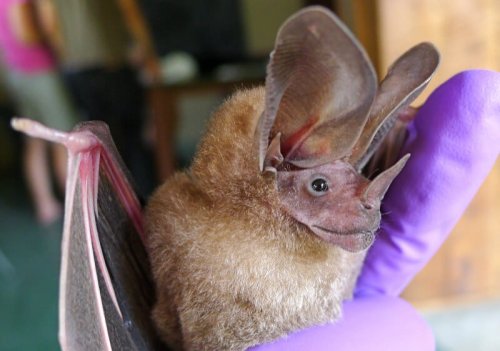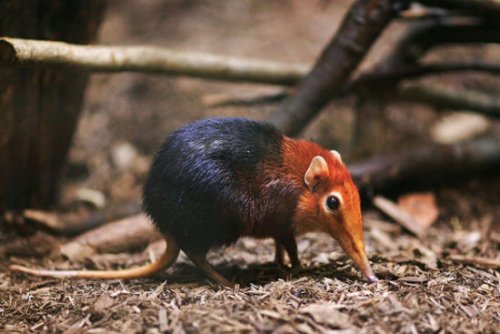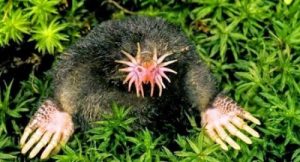The Strangest Animals That Exist

No, they’re not animations or edited photos… These are some of the strangest animals that currently exist. Did you know that humans know less than a fifth of all the animal species on the planet?
Surely there are many more rarities living separate from us. In this article, you will find out about a few species that have caught many peoples’ attention.
The Strangest Animals in the World
They’re really amazing, and although they look like something out of a George Lucas science-fiction film… they’re real! Here are some of the strangest animals that exist (or we currently know of):
1. Cuban Greater Funnel-eared Bat
Its scientific name is Natalus Primus and it belongs to the Natalidae family. Its strange appearance has yellowish-red fur and funnel-shaped ears. This bat is only found on the Isla de la Juventud (Island of Pines), in Cuba. It’s called “Yoda” because it looks like the character from Star Wars.
2. Pink Fairy Armadillo
This animal looks like a Pokémon dressed up like a Princess. It’s a very small armadillo (only 10 cm long) which lives in the Cuyo region of Argentina. It’s silky white fur is covered by a pink shell.
This species spends many hours underground, so it’s difficult to spot them walking on the surface. They don’t like being close to humans and if caught only they live up to a week in captivity.
3. Elephant Shrew
Its scientific name is Macroscelidea, apart from being one of the strangest animals, it also has a very unusual name. Why the “elephant” shrew? It definitely has relationship to the enormous mammal. It’s because it has a long trunk-like snout. It also gets this name because it’s the biggest of all shrews.
They can measure up to 30 cm long (and their tails up to25 cm). They’re mainly daytime animals and hide in cracks in rocks, gaps in tree trunks, or abandoned nests.

4. Aye-Aye
Daubentonia madagascariensis is a mix between a bat, monkey and meerkat. It has enormous eyes, a bushy tail, large ears, and long primate-like fingers, and only lives in Madagascar. In general, they’d rather spend all of their time in tree branches than on the ground. They are nocturnal animals that sleep in a spherical nest made out of sticks and leaves.
5. Northern Hairy-nosed Wombat
Lasiorhinus Krefftii is one of the strangest species of mammal in the world. Although it lived since ancient times in New South Wales, Queensland, and Victoria, today its habitat is limited to a 33 km2 territory at the Epping Forest National Park.
Sadly, it’s at serious risk of extinction. It has a pig-like nose, lynx-like ears, and a squirrel-like body.
6. Star-nosed Mole
Its scientific name is Condylura Cristata and it belongs to the Talpidae family. It lives across North America, although it’s mainly found on the North-eastern coast of the United States.
The star-nosed mole measures 20 cm long and has 44 teeth. It’s main feature (which makes it one of the strangest animals in the world) is its nose that has 22 pinkish moving tentacles which guide it through the darkness. They also help it hunt insects, worms, and crustaceans.

7. Sawfish
With a name like that you can probably imagine what it looks like. This large fish’s nose (they can grow up to 5 m long) is shaped like a saw. Pristis Pristis lives in deep subtropical waters in the Pacific Ocean and belongs to the Pristidae family (related to rays).
8. Harp Sponge
If you’re looking for the strangest animals, this one without a doubt takes first place. This species is shaped like a candelabra… like it was something left in the ocean after a shipwreck. It might look delicate and very elegant, but it’s very dangerous for crustaceans… it devours them rather quickly!
Source of Images: noticiaspet.com, www.infoanimales.com
All cited sources were thoroughly reviewed by our team to ensure their quality, reliability, currency, and validity. The bibliography of this article was considered reliable and of academic or scientific accuracy.
- Abdullah, N., Elias, N., Miard, P., Lim, L. & Ruppert, N. (2019) Ultrasound use by Sunda colugos offers new insights into the communication of these cryptic mammals, Bioacoustics, 28(5), 397-403, https://www.tandfonline.com/doi/full/10.1080/09524622.2018.1463294
- Acosta, X., Corronca, J., Doma, I., González-Reyes, A., Rocha, M., y Repp, E. (2016). Evaluación de la diversidad en comunidades de tardígrados (Ecdysozoa: Tardigrada) en hábitats urbano y rural de la ciudad de Salta (Argentina). Iheringia. Série Zoologia, 106, e2016026. https://www.scielo.br/j/isz/a/WVQvNZdkHmxqY5KmgK6HjGd
- Ávila, V., González, A., González, T. y Vázquez, M. (2021). El género Ambystoma en México ¿Qué son los ajolotes?. CIENCIA ergo-sum, Revista Científica Multidisciplanaria de Prospectiva, vol. 28(2). https://www.redalyc.org/journal/104/10466283011/html
- Balk M., Benfield M., Branch T., Chen C., Cosgrove J., Dove A., Gaskins L., Helm R., Hochberg F., Lee F., Marshall A., McClain C., McMurray S., Schanche C., Stone S. y Thaler A. (2015). Sizing ocean giants: patterns of intraspecific size variation in marine megafauna. PeerJ, 3(715). https://peerj.com/articles/715/
- Bardele, C., Dominguez-Bello, M., Lynn, D., Obispo, N., Schultheiß, S. y Wright, A. (2017). Aviisotricha hoazini n. gen., n. sp., the Morphology and Molecular Phylogeny of an Anaerobic Ciliate from the Crop of the Hoatzin (Opisthocomus hoazin), the Cow Among the Birds. Protist, 168 (3), 335-351. https://www.sciencedirect.com/science/article/pii/S1434461017300214
- Bell-Anderson, K., Campbell, M., Campbell, H., Lawton, T., Udyawer, V. y Westcott, D. (2023) The southern cassowary (Casuarius casuarius johnsonii) remains an important disperser of native plants in fragmented rainforest landscapes. Austral Ecology, 48, 787–802. https://onlinelibrary.wiley.com/doi/full/10.1111/aec.13309
- Blier, P., Campbell, K., Devereaux, M., Munro, D. y Pamenter, M. (2021) Burrowing star-nosed moles (Condylura cristata) are not hypoxia tolerant. Journal Experimental Biology, 224 (19). https://journals.biologists.com/jeb/article/224/19/jeb242972/272464/Burrowing-star-nosed-moles-Condylura-cristata-are
- Bolnick, B., Di Fiore, A., Kirk, E., Lewis, R., Scarry, C. y Veilleux, C. (2016). Group benefit associated with polymorphic trichromacy in a Malagasy primate (Propithecus verreauxi). Scientific Reports, 6 (38418). https://www.nature.com/articles/srep38418
- Brum, S., Campbell, E., Da Silva, V., De Mello, D., De Souza, R., Gonçalves, R., Gravena, W. y Mintzer, V. (2023). The Amazon River dolphin, Inia geoffrensis: What have we learned in the last two decades of research?. Latin American Journal of Aquatic Mammals 20th Anniversary. 18.(1). https://www.lajamjournal.org/index.php/lajam/article/view/1523
- Charbonnier, Y., Papura, D., Rhouy, N., Rusch, A., Sentenac, G. y Touzot, O. (2021). Pest control services provided by bats in vineyard landscapes. Agriculture, Ecosystems & Environment, 306. https://www.sciencedirect.com/science/article/abs/pii/S0167880920303935
- Christensen, C., Couzin, I., Farine, D., Gall, G., Klarevas-Irby, J., Nyaguthii, B. y Papageorgiou, D. (2019). THE MULTILEVEL SOCIETY OF A SMALL BRAINED BIRD. Current Biology, 29. 1120-1121. http://erepository.uoeld.ac.ke/handle/123456789/1533
- Dalén, L., Dussex, N., Jarvis, E. y Robertson, B. (2022). The kākāpō (Strigops habroptilus). Trends in Genetics, Genome of the month, 38(8). https://www.cell.com/trends/genetics/fulltext/S0168-9525(22)00065-8
- Daly, I., How, M., Jared, S., Roberts, N. y Tetley, A. (2017). Colour preference in Odontodactylus scyllarus (Linnaeus, 1758) (Stomatopoda). Journal of Crustacean Biology, 37(4), 374–379. https://academic.oup.com/jcb/article/37/4/374/3865483
- Dehling J. (2017). How lizards fly: A novel type of wing in animals. PLoS ONE 12(12). https://journals.plos.org/plosone/article?id=10.1371/journal.pone.0189573
- Di Blanco, Y., Gaudin T. & Hicks P. (2018). Myrmecophaga tridactyla (Pilosa: Myrmecophagidae). Mammalian Species, 50(956), 1–13. https://academic.oup.com/mspecies/article/50/956/1/4968042?login=false
- Donnellan, S., Rouse, G., Stiller, J. y Wilson, N. (207). The Leafy Seadragon, Phycodurus eques, a Flagship Species with Low But Structured Genetic Variability, Journal of Heredity, 108(2). 152–162. https://academic.oup.com/jhered/article/108/2/152/2631585?login=false
- Du, B., Jiang, Y., Liu, W., Lu, B., Ruan, G., Yang, N. y You, Z. (2022). Spatio-Temporal Niche of Sympatric Tufted Deer (Elaphodus cephalophus) and Sambar (Rusa unicolor) Based on Camera Traps in the Gongga Mountain National Nature Reserve, China. Animals. 12(19). https://www.mdpi.com/2076-2615/12/19/2694
- Garde, E., Graham, Z., Heide-Jørgensen M. y Palaoro A. (2020). The longer the better: evidence that narwhal tusks are sexually selected. Biology Letters, 16(3). https://royalsocietypublishing.org/doi/full/10.1098/rsbl.2019.0950
- Grange, S., Kümpel, N., Mallon, D., Mapilanga, J., Queslin, E. y Quinn, A. (2015). Okapi (Okapia johnstoni) : conservation strategy and status review. Gland: IUCN and Institute Congolais pour la conservation de la nature, 6. https://portals.iucn.org/library/node/45844
- Haddock, S. y Johnsen, S. (2022). Macropina. Current Biology, 32(6), 256-257. https://www.sciencedirect.com/journal/current-biology/vol/32/issue/6
- Kabir, A. (2015). Most Beautiful Pigeons of Bangladesh. Animal and Veterinary Sciences. 3(2), 34-37. https://www.researchgate.net/publication/333682619_Most_Beautiful_Pigeons_of_Bangladesh
- Marks, J., Reid, M. y Vickers, R. (2023). First report of nectar robbing by sword-billed Hummingbirds Ensiferera Ensifera. Ornitología Neotropical. 34(2). https://www.researchgate.net/publication/373457868_FIRST_REPORT_OF_NECTAR_ROBBING_BY_SWORD-BILLED_HUMMINGBIRDS_ENSIFERA_ENSIFERA
- Martineau D., Measures L. y Lair S. (2016). Pathologic Findings and Trends in Mortality in the Beluga (Delphinapterus leucas) Population of the St Lawrence Estuary, Quebec, Canada, From 1983 to 2012. Veterinary Pathology, 53(1), 22-36.https://journals.sagepub.com/doi/full/10.1177/0300985815604726
- Marushchak, A., Marushchak, O., Nekrasova, O. y Tkachev, D. (2022). The Data on the Reproductive Biology of the Satanic Leaf-Tailed Geko, Uroplatus phantasticus (Squamata, Gekkonidae), at the BION Terrarium Center as a Contribution to ex situ Offspring Programs. Zoodiversity, 56(1). http://ojs.akademperiodyka.org.ua/index.php/Zoodiversity/article/view/304
- Matsumoto, Y., Miglietta, M. y Piraino, S. (2019). Transcriptome Characterization of Reverse Development in Turritopsis dohrnii (Hydrozoa, Cnidaria), G3 Genes|Genomes|Genetics, 9(12), 4127–4138. https://academic.oup.com/g3journal/article/9/12/4127/6028122
- Oliveira, L., Printes, R. y Schulz, F. (2021). Conflicts with Pumas in Southern Brazil: The Farmers’ view en M. Campbell (Ed.) y K. Kumar Jha (Ed.), Critical Research Techniques in Animal and Habitat Ecology: International Examples (pp. 201 – 224). Nova Science Pub Inc.
- Peterson, A. y McHenry, M. (2022). The persistent-predation strategy of the red lionfish (Pterois volitans). Proceedings of the royal society, 289(1980). https://royalsocietypublishing.org/doi/full/10.1098/rspb.2022.1085